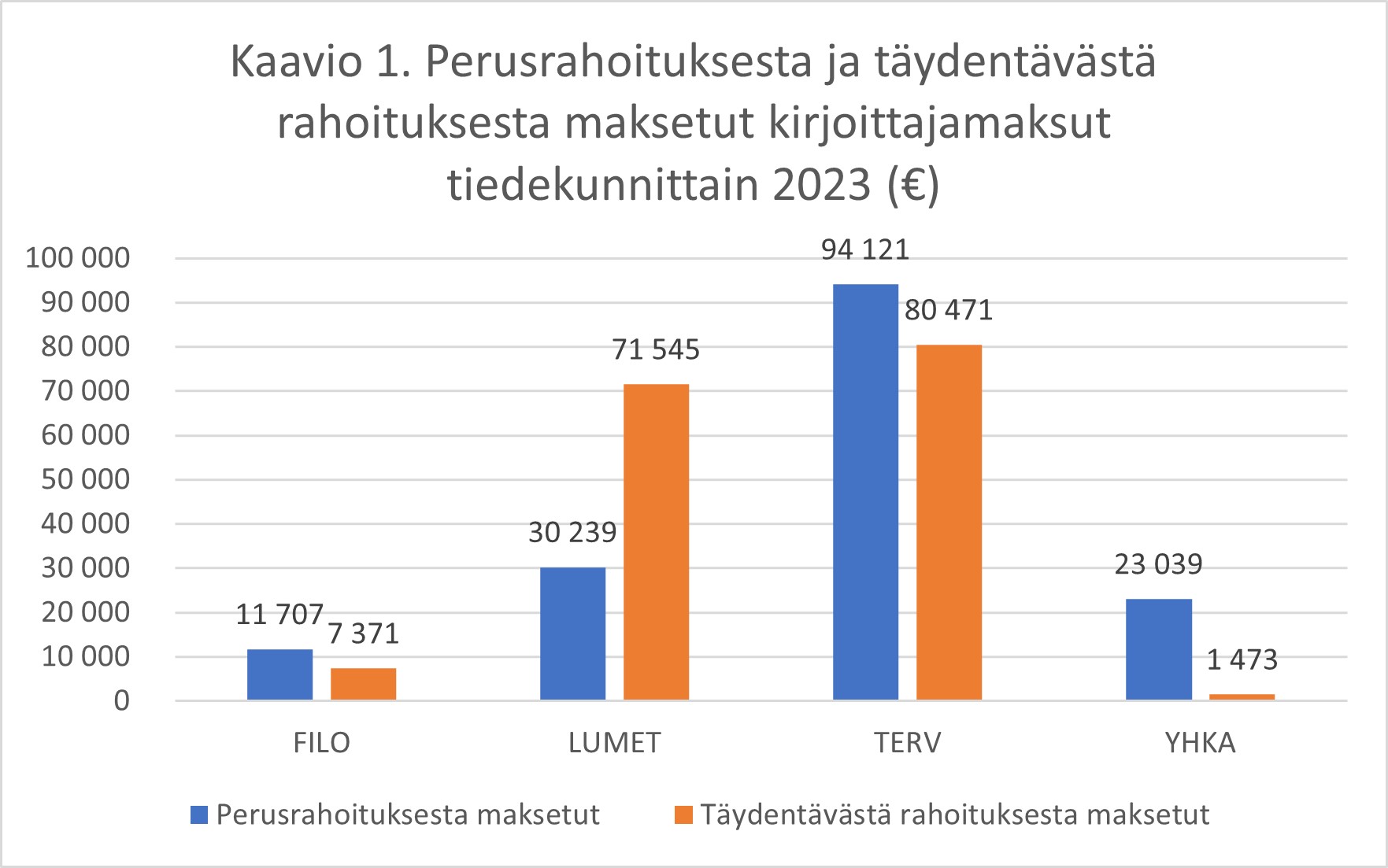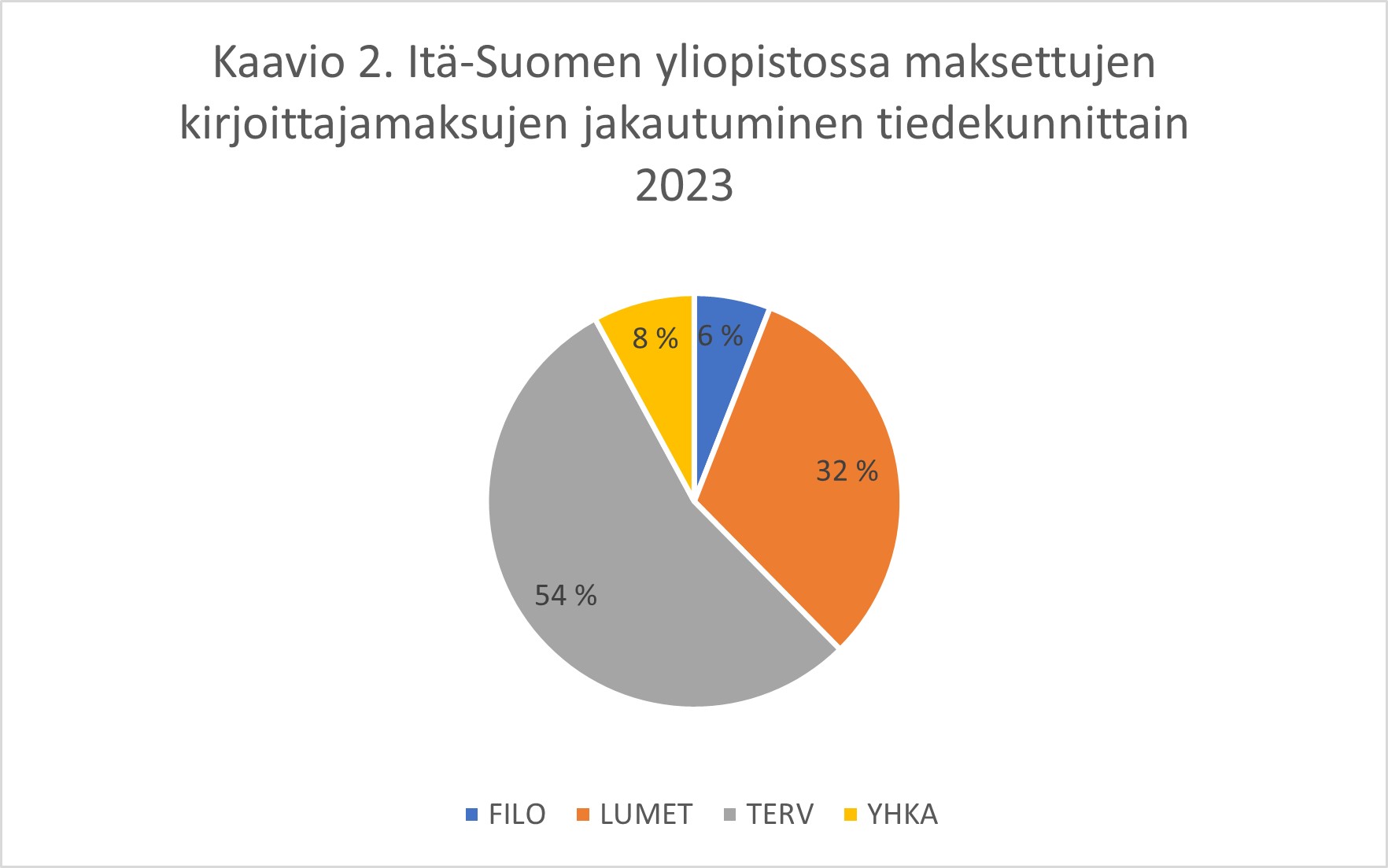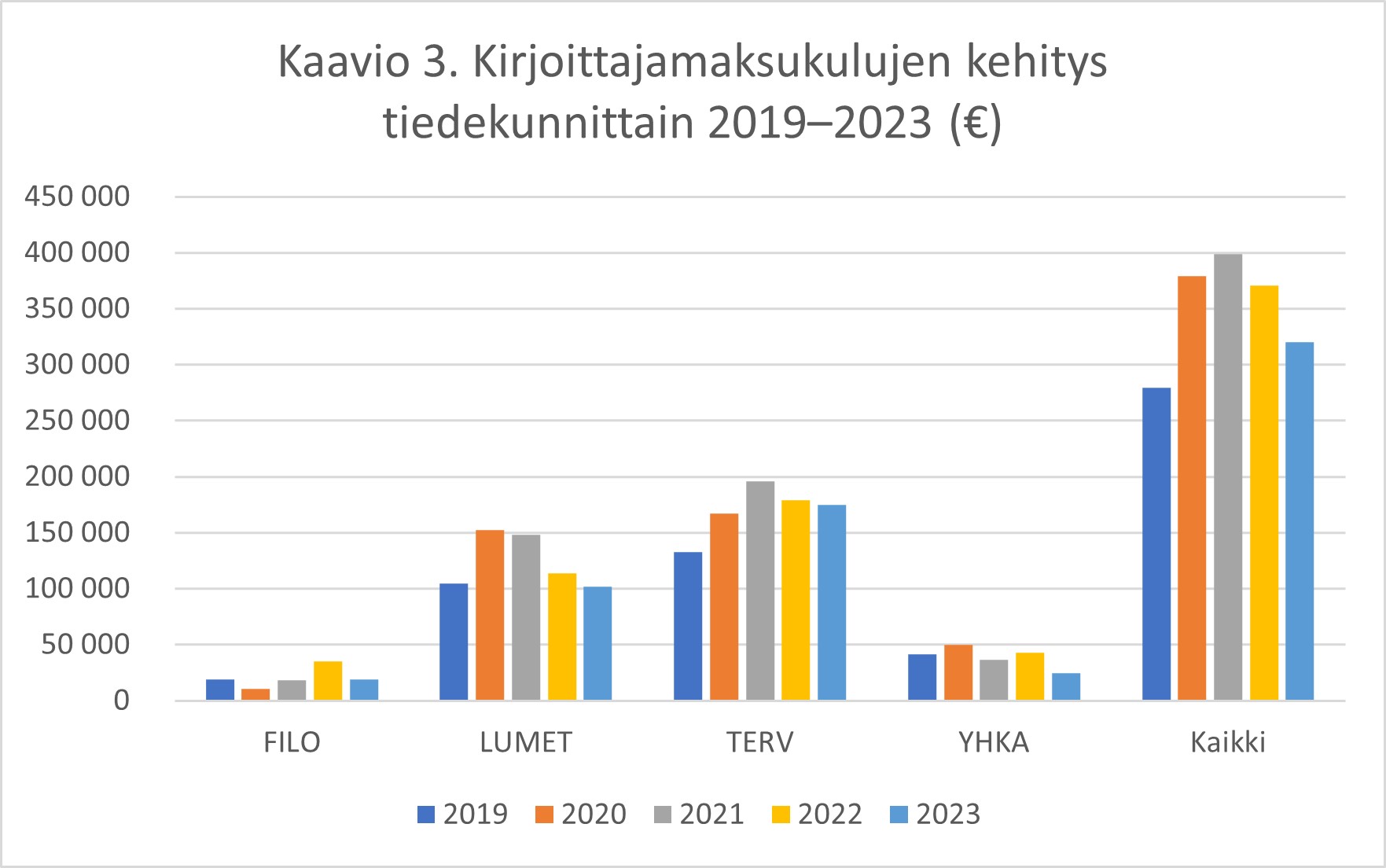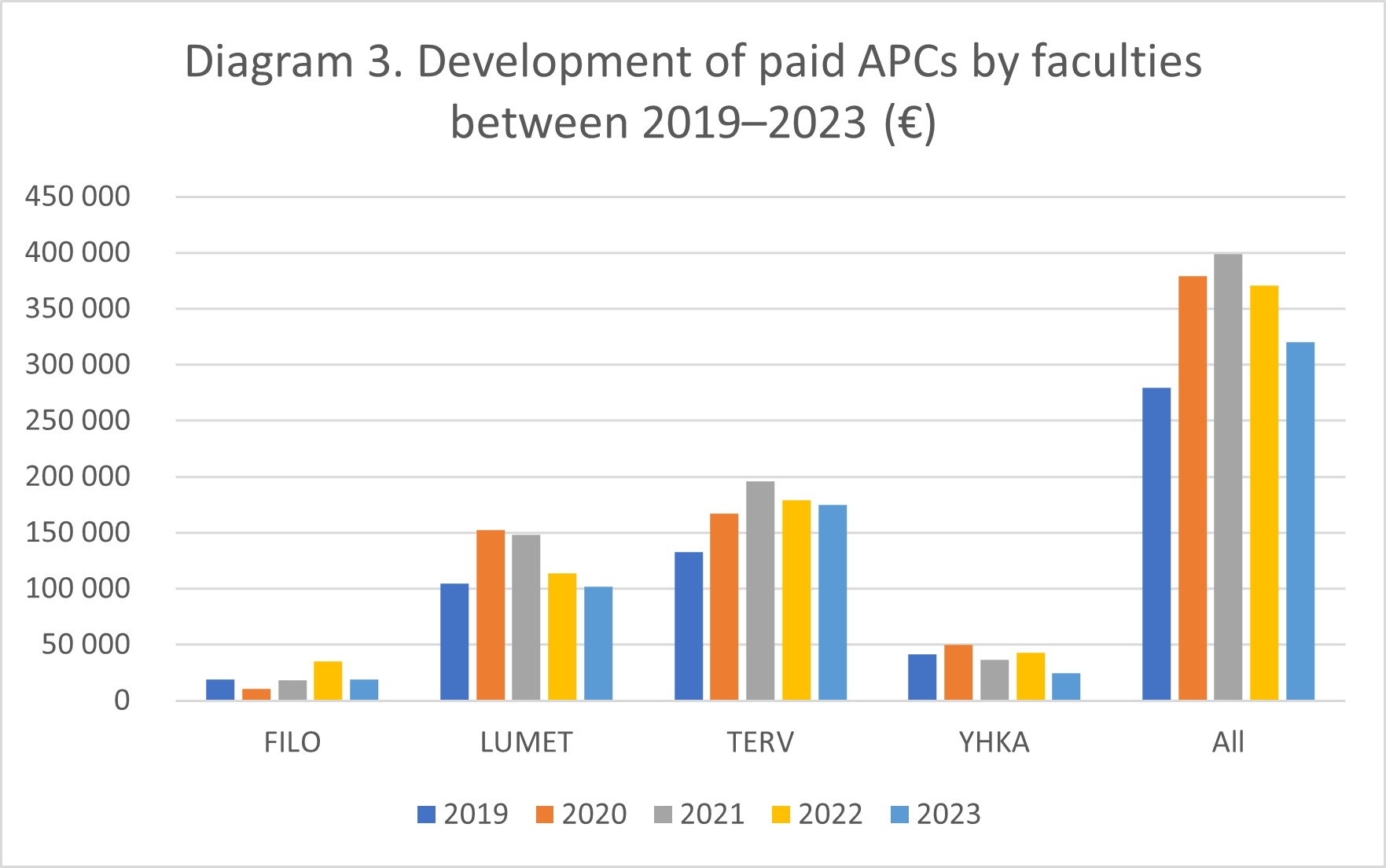Kirjoittajamaksut Itä-Suomen yliopistossa 2023 | Article processing charges in the University of Eastern Finland 2023
(Please, scroll down to read in English.)
Oli synkkä ja myrskyinen yö. Yhtäkkiä kirjaston tietoasiantuntija hätkähti hikisenä hereille salaman iskiessä hänen tajuntaansa: viime vuoden kirjoittajamaksuista ei ole vielä kirjoitettu blogikirjoitusta! Miksi ihmeessä, kun talouspalveluista saatiin toteumaraportti jo ajat sitten ja maksutiedot on syötetty UEF CRISiinkin jo heti alkuvuodesta? Syy jääköön arvon lukijan arvailtavaksi, sillä kirjoittajalla on jo kiire panna töpinäksi.
Luku 1: Pitkä ja komea muukalainen saapuu
Heti vuoden 2023 alussa yliopiston kirjoittajamaksuja seuraavat saivat kokea mullistuksen. Kaupunkiin ratsasti pitkä ja komea muukalainen nimeltä Martti, lisänimeltään ”ostolaskujen käsittelyjärjestelmä”. Kaupungin edellinen seriffi, Rondo (sattumalta samalla liikanimellä siunattu), oli luikkinut teille tietymättömille vuodenvaihteessa. Tuskin olivat saluunan ovet heilahtaneet, kun tilikartat oli Martin myötä laitettu uusiksi myös kirjoittajamaksujen osalta. Tilien uudistamisen myötä alkoivat uudet tuulet puhaltaa preerialla: nyt saataisiin aiempien seurantatietojen lisäksi eriteltyä myös monografioiden ja kokoomateosten artikkeleiden avaamisesta maksetut kulut sekä selville JUFO-luokkien 1-3 ulkopuolisiin lehtiin maksetut kirjoittajamaksut. Kaupungin väki pidätti hengitystään uusia lukuja odottaessaan, vain arokierijä uskalsi rikkoa hiljaisuuden pyöriessään pääkadun halki.
Yhtäkkiä kajahti laukaus! Sydän hyppäsi kurkkuun monella, mutta huoleen ei ollut syytä. Lennätinvirkailija siellä vain ilmoitti kirjoittajamaksuseurannan lukujen saapuneen talouspalveluista. Tietoasiantuntija keskeytti lukutikun vuolemisensa, taittoi veitsen taskuun, poimi silmälasit mukaansa ja suuntasi kadun yli kuulemaan lukuja.
Luku 2: Numerot eivät valehtele
Kello kilahti lennätintoimiston oven yläpuolella ja lattialankku narahti, kun tietoasiantuntija astui sisään. Sähköttäjä nyökkäsi tervehdykseksi, nojasi taaksepäin tuolissaan ja virkkoi:
– No niin, nyt niitä summia sitten olisi tässä.
– Terve vaan. Miltäs ne näyttää?
– Viime vuonna, siis 2023, kirjoittajamaksuja maksettiin lehtiartikkeleista yhteensä 319 966 eurolla.
– No huh! Yhteissumma siis laski edelliseen vuoteen verrattuna 50 478 euroa – se tekee melkein 14 prosenttia.
– Joo, niin laski. Montakos artikkelia siinä teidän kirjaston omassa seurannassa muuten oli?
– 121 artikkelia. Jos tässä nyt nopeasti päässä lasken, niin se tarkoittaisi artikkelin keskihinnaksi 2 644 euroa. Se olisi melkein 600 euroa enemmän kuin edellisenä vuonna. Mahtaakohan tuo pitää paikkansa?
– Jaa-a. Voihan se olla, että ihan jokainen kirjoittajamaksu ei ole teidän kauttanne kiertänyt. Tai sitten artikkeleita on tosiaan julkaistu kalliimman kirjoittajamaksun lehdissä.
– Voi se olla niinkin. Mitenkäs ne summat jakautuvat rahoituslähteittäin? Viime vuosina niiden suhteelliset osuudet ovat vähän vaihdelleet.
– No vuonna 2023 puntit menivät melko lailla tasan. Kokonaisiin prosentteihin kun pyöristetään, niin sekä perusrahoituksesta että täydentävästä rahoituksesta maksettiin molemmista 50 prosenttia kirjoittajamaksuista. Jos muuten kiinnostaa, niin minulla on tässä ihan kaavion muodossa esiteltynä perusrahoituksesta ja täydentävästä rahoituksesta maksetut kirjoittajamaksut tiedekunnittain. Tuosta, kaavio 1. Aika samansuuntaiselta kyllä näyttää kuin vuonna 2022, mutta filosofisen tiedekunnan perusrahoituksesta maksetut maksut ovat tippuneet miltei kolmannekseen edellisestä vuodesta.

– No niinpä näkyy. Ja terveystieteiden tiedekunnan kohdallakin perusrahoituksesta on nyt maksettu enemmän kuin täydentävästä. Edellisvuonnahan oli toisin päin. Muuten, nyt kun siirryttiin tiedekuntatasolle, niin mitenkäs ne kirjoittajamaksut ylipäänsä jakautuivat tiedekuntien välillä?
– Siitäkin minulla on havainnollistava kuvitus, katsopa tätä kaaviota 2.

– Taisit oikaista ja kopioida suoraan edellisen vuoden kaavion? Jaa, no, onhan tuossa muutaman prosenttiyksikön heittoja. Terveystieteiden tiedekunnan osuus on kasvanut jo yli puoleen kokonaissummasta ja yhteiskunta- ja kauppatieteiden tiedekunnan osuus laskenut muutaman prosenttiyksikön. Luonnontieteiden, metsätieteiden ja tekniikan tiedekunnan sekä filosofisen tiedekunnan osuudet sen sijaan ovat miltei samat kuin 2022.
– Minä en oikaise koskaan, kun on kaavioista kyse. Esimerkiksi tähän kaavioon 3 lisäsin ihan omin käsin vuoden 2023 summat kirjoittajamaksuista jokaisen tiedekunnan kohdalle. Siitä siis näkee, miten maksetut summat ovat vaihdelleet vuosina 2019–2023.

– Tuo on kyllä siitä hyvä kaavio, että siitä näkee heti erot edellisiin vuosiin. Mutta yhdestä asiasta sinulla ei ole ollut ainakaan viime vuosina kaaviota, ja se on noiden kirjoittajamaksujen jakautuminen kokonaan avointen lehtien ja niin sanottujen hybridilehtien välillä.
– Eikä ole nytkään. Mutta sen verran voin sanoa, että kokonaan avoimiin lehtiin maksettujen maksujen osuus nousi 13 prosenttiyksiköllä 83 prosenttiin. Hybridilehtien osuus tipahti 18 prosenttiyksiköllä 12 prosenttiin. Ja hyvänä päässälaskijana varmaan huomasit, että tuosta tulee yhteensä vain 95 %. Mitäs arvelet niiden puuttuvan viiden prosentin olevan?
– Eipä tarvitse arvella, kun tiedän. Niissä uusissa tileissä on sellainen tili, johon laitetaan kirjoittajamaksut JUFO-luokittelemattomiin lehtiin tai JUFO 0-luokan lehtiin. Niitä oli se viisi prosenttia kokonaissummasta. Ja jos katson kirjaston omaa seurantataulukkoa, niin sen mukaan melkein kaikki niistä ovat menneet kokonaan avoimiin lehtiin. Eli kokonaan avointen lehtien osuus on oikeasti jossain 85–88 % välissä.
– Ollaanpas sitä nokkelalla päällä tänään. Nyt kun mainitsit ne uudet tilit, niin siellähän on nykyään tili myös monografioista ja kokoomateosten artikkeleista maksetuille kirjoittajamaksuille. Englanniksi puhutaan myös termillä book processing charges, tai lyhyemmin BPC. Niitä maksettiin viime vuonna 67 502 euron edestä.
– Onpa se sekin rahaa! Kirjasto on noita aiempinakin vuosina jotenkin pyrkinyt seuraamaan, vuonna 2022 niitä maksettiin 16 500 euroa enemmän. Eli heittelyä on. Mutta toisaalta ero voi tulla jo siitä, että ostetaan yksi kokonainen kirja avoimeksi.
– Näinpä. Mutta siinä olivat minun lukuni.
– Kiitos vaan, nähdään sitten taas vuoden päästä.
Kello kilahti oven päällä, kun tietoasiantuntija astui ulos porottavaan iltapäivän aurinkoon. Ilma oli rutikuiva. Tuulenvire oli kadonnut eikä edes tomu jaksanut nousta kadulta, kun sankarimme lampsi kohti saluunaa sarsaparillan toivossa. Jossain takaraivossaan hänellä jyskytti ajatus siitä, että jotain jäi kysymättä.
Luku 3: Jäävätkö jotkin kysymykset avoimiksi?
Juomanlaskija korkkasi ja asetti sarsaparillapullon tietoasiantuntijan eteen.
– Siitäpä. Sinultahan muuten voi kysyä noista avoimen julkaisemisen asioista?
– Monet kysyvät, juu.
– Ei kun sillä vaan, kun ajattelin tarjotella yhtä käsikirjoitusta joihinkin lehtiin ja mietin, että voisiko niissä lehdissä julkaista avoimena ilman kirjoittajamaksua. Jos minä katson tuolta muistiinpanoista ne lehtien nimet, niin katsoisitko, kuuluuko ne yliopiston avoimen julkaisemisen sopimuksiin?
– Katsonhan minä, mutta nyt minulla ei ole lehtilistoja mukanani. Mutta voit itse asiassa itsekin sen asian tarkistaa, meillä on nykyään käytössä sellainen Journal Search Tool -palvelu, josta voit tarkistaa vaikkapa lehden nimellä hakemalla, kuuluuko se lehti sopimuksiimme.
– No sehän kuulostaa kätevältä!
Baarimikko poistui takahuoneeseen naputtelemaan. Samalla tietoasiantuntijan päähän pälkähti, että totta tosiaan, sopimusten kauttahan julkaistaan nykyään artikkeleita avoimena paljon enemmän verrattuna artikkeleihin, jotka ostetaan erikseen avoimiksi. Tietoasiantuntija kaivoi läppärin laukustaan ja ryhtyi ynnäämään viime vuonna sopimusten kautta avoimena julkaistuja artikkeleita. Eri kustantajien järjestelmissä aikansa pyörittyään hän sai luvut ojennukseen. Itä-Suomen yliopiston ja Kuopion yliopistollisen sairaalan kirjoittajien artikkeleita julkaistiin avoimena sopimusten kautta vuonna 2023 yhteensä 454 kappaletta. Muutama artikkeli toki odotti laskentahetkellä vielä julkaisupäätöstä, joten luku ei ollut vielä lopullinen. Tietoasiantuntija myhisteli tyytyväisenä, sillä artikkelien yhteismäärä oli melko lähellä edellisen vuoden lukua 469 – eiköhän yhteenlasku siis ollut onnistunut.
Pahimman janon sammuttua ja mielen tyynnyttyä viimeaikaisesta lukujen pyörittelystä tietoasiantuntijamme keskushermostoon väljeni tilaa uusille ajatuksille. Niinpä muistiin nousi asia, jota ei sähköttäjältä tullut kysyttyä, nimittäin maksettujen kirjoittajamaksujen jakautuminen kustantajittain. Kaikkina edellisinä vuosinahan tuota kuitenkin seurattiin oikein kaavion kanssa! No, ajatteli tietoasiantuntija, ehkäpä se kaavio on jo aikansa elänyt. Näkyväthän eri kustantajille maksetut osuudet muutenkin hyvin havainnollistettuna OpenAPC-palvelussa, kunhan vuoden 2023 tiedot sinne päivittyvät heinäkuussa.
Olipahan siinä päivä, tuumi tietoasiantuntija illalla painaessaan päänsä pielukselle. Ei ole aina niin yksinkertaista seurata avoimen julkaisemisen kuluja – mitä maksetaan mistäkin, mikä tiliöidään minnekin ja minkä sopimuksen kautta mikin artikkeli on avattu. Ei se ihme siis ole, jos luvuissa hieman on heittoa esimerkiksi OpenAPC:hen vietyjen summien ja talouspalveluista saatujen raporttien välillä. Mutta, lohduttautui numeroniilomme silmäluomien jo lupsaessa, tärkeintä ei tässä tapauksessa liene summat sentilleen, vaan suurpiirteisemmät linjat ja mittakaavan hahmottaminen.
Tämän kirjoituksen hahmot ja tapahtumat ovat kuvitteellisia. Esitellyt summat ja luvut sen sijaan pitävät paikkansa ja kuvaavat tilannetta Itä-Suomen yliopistossa huhtikuun lopulla 2024.
____________________
In English
It was a dark and stormy night. All of a sudden, the Library’s Information Specialist woke up sweaty as lightning struck his mind: no blog had yet been written about last year’s article processing charges! Why on earth was this the case, when the report on APC costs was received long ago from the Financial Services, and the APC information had already been entered into UEF CRIS early in the year? The reason is left for the reader to deduce, as the author is already in a hurry to get to writing.
Chapter 1: A tall handsome stranger arrives
At the beginning of 2023, those following the university’s article processing charges experienced an upheaval. A tall and handsome stranger named Martti, nicknamed the “purchase invoice system,” rode into the town. The town’s previous sheriff, Rondo (by chance blessed with the same epithet), had disappeared at the turn of the year. The doors of the saloon had hardly swung when the charts of the APC accounts had been redesigned for Martti.
With the account renewal, new winds began to blow on the prairie: now, in addition to previously monitored information, the fees paid for opening monographs and book chapters could also be specified, as well as the APCs paid for journals outside JUFO categories 1-3. The townspeople held their breath while waiting for the new figures, only a tumbleweed dared to break the silence as it rolled across the main street.
Suddenly, a shot rang out! A few hearts jumped into throats, but there was nothing to worry about — it was merely the town’s telegrapher signaling that the APC report had arrived from the Financial Services. The Information Specialist interrupted the whittling of his reading stick, folded the knife in his pocket, picked up his glasses, and headed across the street to hear the figures.
Chapter 2: Numbers don’t lie
The bell tinkled above the telegraph office door and the floor plank creaked when the Information Specialist stepped in. The telegrapher nodded in greeting, leaned back in his chair, and started:
– Howdy. You wanted to see the new figures?
– Yeah, sure. How do they look?
– Well, last year, that is to say 2023, the university paid a total sum of €319,966 for APCs. Now, that sum is only for the articles published in journals.
– Gee whiz! So the sum decreased from 2022 by €50,478 – that’s almost 14 per cent!
– That’s right. I understand that you have some sort of APC monitoring spreadsheet of your own in the library. How many articles were there in that file for 2023?
– 121 articles. If I count this quickly, it will mean an average charge of €2,644 per article. That would be almost 600 euros more than in the previous year. Could that be correct?
– Well… Maybe every APC invoice has not been circulated through you? I don’t know, it might just be that the articles were published in journals which have higher APCs.
– Yeah, it could be like that. How about the sources of funding?
– Well, in 2023, the paid APCs distributed quite evenly between basic and external funding. In round numbers, 50% of the total APCs were paid from both sources of funding. As a matter of fact, I have a diagram here about the distribution of APCs paid from basic and external funding by faculty. Here, diagram 1. Although it does looks very similar to the 2022 diagram, you can see that the fees paid from the basic funding of the Philosophical Faculty have decreased to almost one third of the previous year.

– Yeah, so it seems. Also, the Faculty of Health Sciences paid more APCs from the basic funding than from the external funding. Last year it was the other way around. By the way, now that we moved to the faculty level, how were those APCs distributed between the faculties?
– I have an illustration of that too, take a look at this diagram 2.

– You took a shortcut and copied the chart from the previous year, didn’t you? Well, there does seem to be a few minor variations. The share of the Faculty of Health Sciences has grown to more than half of the total, and the share of the Faculty of Social Sciences and Business Studies has decreased by a few percentage points. The shares of the Faculty of Science, Forestry and Technology and the Philosophical Faculty, on the other hand, are almost the same as in 2022.
– I never cut corners when it comes to diagrams, you know that. For example, I personally added the sums of the APCs paid by each faculty in 2023 to the diagram 3, so you could see how the sums have varied between 2019–2022.

– Very smart. But I guess you still don’t have a diagram about the distribution of the paid APCs between fully Open Access journals and the so-called hybrid journals?
– Nah. But what I can say is that the share of the APCs paid for fully Open Access journals increased by 13 percentage points to 83%. The share of hybrids dropped by 18 percentage points to 12%. And as you are so good with mental arithmetic, you probably noticed that those numbers together make only 95%. What do you think the missing 5% is? Any guesses?
– I don’t need to guess what I already know. That new Martti has an account where you put the APCs for journals that don’t have a JUFO classification, or whose class is 0. That was the 5% of the total. And if I look at the library’s own monitoring table, it says that almost all of them have been paid to fully Open Access journals. So, the share of the APCs paid for fully OA journals is somewhere between 85-88%.
– Well, aren’t you witty today. Now that you mentioned the new accounts, there is also the account for the APCs paid for books and book chapters. They are sometimes referred as book processing charges, or BPC for short. Last year, the university paid 67,502 euros worth of BPCs.
– That’s a hefty sum too! We at the library have tried to monitor those BPCs too earlier, in 2022 the sum was €16,500 bigger. However, as the BPCs for whole books can be quite high, the sums can vary easily.
– Yeah. Well, that’s all the figures I have for now.
– OK, thanks. See you next year.
The floor creaked and the bell tinkled again as the Information Specialist stepped outside to the scorching afternoon sun. The air was dry as a desert. The breeze was gone, even the dust in the ground kept still when our hero dragged his legs towards the saloon in hope for some sarsaparilla. Somewhere in the back of his mind was a nagging thought that he’d forgotten something.
Chapter 3: Will some questions remain open?
The barkeep opened a bottle of sarsaparilla and placed it in front of the Information Specialist.
– Here you go. By the way, weren’t you the guy who knew about these Open Access publishing things?
– So they claim.
– See, I’m about to send my manuscript to some journals, and I’m wondering if I could publish the article in Open Access without article processing charges? I heard that the university has some Open Access agreements that would allow this with certain publishers. I have the names of those journals written down somewhere, could you check them if I find them for you?
– Yeah, sure. But I don’t have the journal lists with me right now. Actually, you could also check if the journals are included in our agreements by yourself with our new Journal Search Tool. You can just type the journal’s title in the search box and see if the journal is included in our agreements.
– Well that sounds swell! Thanks, I’ll look into it.
The bartender moved to the back room to search for the journals in the new tool. The conversation left the Information Specialist thinking. It occurred to him that, in fact, more articles are nowadays published via OA agreements compared to articles that are made Open Access through separate purchases. The Information Specialist dug a laptop out of his bag and started adding up the articles published Open Access through agreements last year. After spending his time in the systems of various publishers, he got the numbers to match. In 2023, a total of 454 articles with corresponding authors from University of Eastern Finland or Kuopio University Hospital were published Open Access via these agreements. Of course, a few articles were still awaiting publication at the time of the calculation, so the sum was not yet final. Since the total number of articles was quite close to the previous year’s figure of 469, the Information Specialist was pleased to see that he had probably been able to add the figures from the different systems together correctly.
When his worst thirst had quenched and his mind calmed after the summing of figures, the Information Specialist had room in his brain for some new thoughts. That’s when it hit him: he had forgotten to ask the telegrapher about the distribution of APCs by publisher! For all previous years, that information had been monitored and presented as a chart! Well, thought the Information Specialist, maybe there’s a time and a place for everything, and now it might be the time to part with that chart. After all, the data will be well-illustrated in OpenAPC when the numbers from 2023 will be updated there in July.
What a day, sighed the Information Specialist laying his head on the pillow at nightfall. It’s not always so simple to monitor the costs of Open Access publishing – what is being paid from where, what costs are posted on which account, or what is being published via which agreement. It’s no wonder that there might be some discrepancies between the reports received from the Financial Services and the sums seen in OpenAPC. So, as his eyelids began to droop, our Information Specialist consoled himself with the thought that the most important thing in this case are not the sums to a cent, but the broader outlines and the perception of scale.
The characters and events in this blog post are fictional. The sums and figures presented, on the other hand, are actual and describe the situation at the University of Eastern Finland in late April 2024.
Juho Jussila, tietoasiantuntija | Information Specialist
Tietoaineistopalvelut | Collection Services
Special thanks to Niko Niskanen for the English proofreading.